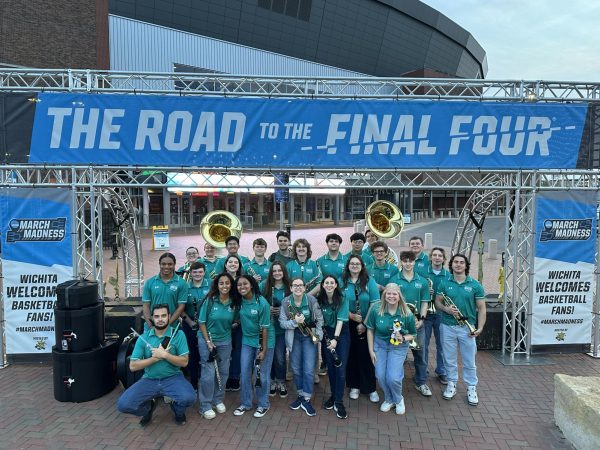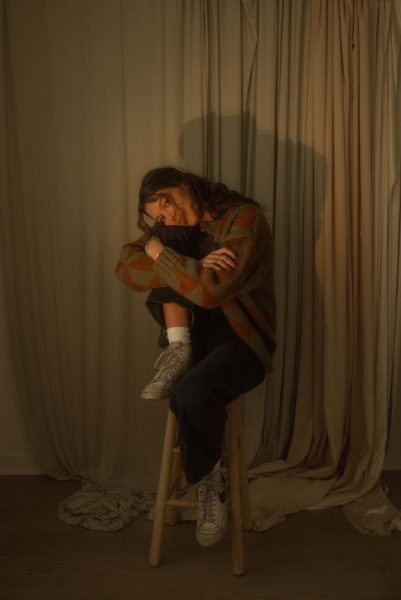The National AIDS Memorial Quilt remembers a generation lost to disease and prejudice
As students return to class for the spring semester, many may overlook various artworks on display across campus. One such piece is the AIDS Memorial Quilt, which recently left the Cultural Arts Building and Randall Library as part of an annual display from Dec. 1, 2022 to Jan. 31, 2023. Each year the quilts spark local conversation surrounding HIV/AIDS and its impact on history. While only a temporary display, it serves as a reminder of the very real battle so many face against the virus even today.
Each quilt panel is part of the exponentially larger 54-ton national quilt, made up of nearly 50,000 individual panels. Each panel features eight memorial patches that measure three by six feet, roughly the size of a grave. Sewn on them are the names of more than 109,000 people lost to HIV/AIDS during the epidemic that started in the early 1980s. Parts of the quilt were displayed throughout Wilmington since Dec. 1 for National AIDS Day.
According to the National AIDS Memorial, the quilt was first conceived in 1985 San Francisco during the height of the AIDS epidemic. Activist Cleve Jones created the quilt as a way for friends and family to honor loved ones lost to the virus.
Jones organized a candlelight march following the assassinations of California’s first openly gay politician, city supervisor Harvey Milk, and openly gay mayor George Moscone in 1985. He asked those marching to create plaques with the names of friends and loved ones lost to the epidemic. After hundreds of plaques were placed on the San Francisco federal building, they reassembled a patchwork quilt.

Inspired by the display, Jones envisioned with fellow activists a quilt that could honor the lives they feared would be lost to history. After showcasing the quilt in a small storefront, national attention swiftly followed. Cities around the country began sending the San Francisco workshop their own panels. Some people donated sewing supplies, while others volunteered to create the quilt. On Oct. 11, 1987, the quilt would be displayed for the first time at the National Mall in Washington D.C.
As the quilt grew exponentially over the years, it would be displayed in Washington again in 1988, 1989, 1992 and finally in 1996, by which point the quilt became too large to display in its entirety.
According to Chris Robinson, UNCW’s Outreach and Engagement Librarian, the display at Randall was part of an annual collaboration between UNCW’s Department of Anthropology, SEEDS of Healing, the LGBTQ Center of the Cape Fear and other community partners to bring panels of the quilt to locations across Wilmington.
“The quilt has been on display three times since I started at the university in 2018,” Robinson said. “The exhibition highlighted the breadth and depth of HIV/AIDS and its impact on humanity locally, nationally, and globally. I hope students took a moment to take it all in.”
One organization that works to bring portions of the quilt to Wilmington year after year is SEEDS of Healing, a non-profit dedicated to HIV/AIDS advocacy and community support in the Cape Fear area.
Dr. LeShonda Wallace is the organization’s founder and executive director. She created the non-profit in honor of her mother Luwana Daniels, known by friends and family as “Pumpkin.” A single mother living with HIV, Daniels was diagnosed in 1990 and didn’t seek medical care until six years after she contracted the virus.
“My mom was a very faithful person,” Wallace said. “She truly relied on her relationship with God and her spirituality for her healing. When she found out she was HIV-positive, her strategy for healing was based solely in prayer.”
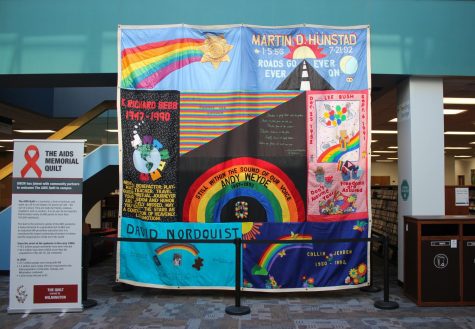
Because of the stigma surrounding HIV at the time, Daniels was reluctant to receive care until 1996. By that point, Wallace said, it was too late—Daniels would eventually succumb to the virus in 1998, only eight years after her diagnosis.
Wallace founded the organization as Pumpkin SEEDS LLC in 2015 and later reorganized as a non-profit in 2016. SEEDS of Healing offers free testing services, referral to medical care and community outreach services. Part of their community outreach initiative includes an annual collaboration with other organizations to bring the AIDS Memorial Quilt to Wilmington.
“We participated in bringing the quilts to the area not only to commemorate those who have succumbed, but also to generate a conversation to bring about an awareness and acknowledgement that the epidemic still exists, and people still need to remain vigilant to eradicate HIV altogether,” said Wallace. “I actually contributed a panel in honor of my mother. It’s a way to grieve, it’s a coping strategy and it promotes community.”
Wallace noted that a lack of education surrounding HIV continues to disproportionately affect marginalized communities. According to research from the US Census Bureau in a 2019 report, Black and Latino Americans represented 70% of those living with HIV today, yet account for only 32% of the general population.
“The only way we can make sure that everyone has some form of acknowledgement is to use a multi-faceted approach to reach people and let them know they’re still at risk,” Wallace said. “There are services, and we can be a conduit for people to get those services, and then if you are negative, we can help you with the tools to keep you negative.”
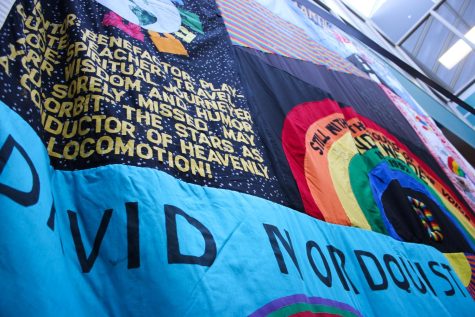
Working alongside Dr. Wallace in local HIV advocacy and prevention is Ed Adams, Program Coordinator of the LGBTQ Center of the Cape Fear Coast. In addition to creating a safe space for the LGBTQ community, the center works year-round in collaboration with SEEDS of Healing to bring the memorial quilt to Wilmington and provide HIV testing services. Adams is a long-term survivor of HIV, being diagnosed in 1982. As a recent retiree, he dedicates much of his time to local queer advocacy and HIV education.
Originally born in Virginia, Adams graduated from Radford University in 1982 before moving to Washington, DC that same year. There, he discovered a thriving gay community that stood in stark contrast to an oppressive national mindset. DC’s local bars and nightclubs offered a rare safe space for queer people to express themselves freely.
“Imagine yourself, your senior year, you step out into the world and think: ‘Oh, I’m going to move to Washington, DC, because that’s where wonderful gay society is,’” Adams said. “You move to a big city—that’s what we did back then. I literally stepped right into the HIV epidemic.”
Adams contracted HIV within his first year living in D.C. He noted that at the time, a lack of education surrounding HIV prevention only exacerbated its impact on the queer community.
“It wasn’t a known thing even then,” Adams said. “My first couple of sexual experiences were just meeting people out in D.C. By 1983, I was infected. Right off the bat—no warning, no ‘remember, use a condom,’ none of that was there.”
During the 1980s, Adams watched countless friends pass away from AIDS, which was largely untreatable and misunderstood at the time. The first drug approved by the USDA for reducing HIV patients’ risk of AIDS wouldn’t come until 1987. Even still, the first medicines available to treat HIV were not always effective and came with a myriad of adverse side effects.
“I can name a hundred names off the top of my head,” Adams said. “I don’t think people grasp what that’s like. It’s like we went to war. There are sleepless nights, and there are memories of my friend Brandon who was the first one to pass. There are mornings that I wake up in a dead sweat, or really upset. He was my best friend. Me and Brandon were 20 when we met; at 25, he was dead.”
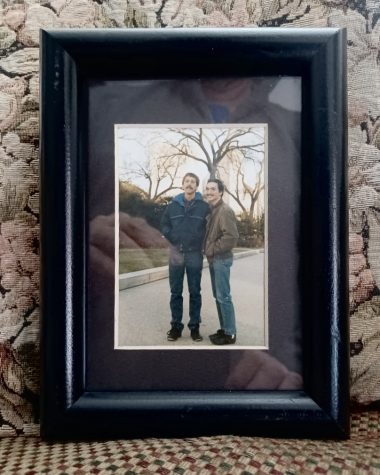
Adam described his friend Brandon as being compassionate, outgoing, funny and above all else, “absolutely brilliant.” The two met at a bar in Dupont Circle, the beating heart of D.C.’s queer scene, and spent much of their time together exploring the city and reveling in the vibrant local nightlife. As his first ever gay friend, Adams said they were inseparable. Eventually, though, Brandon discovered that he had contracted HIV. He immediately sought treatment, but as the high cost of his medications became too much to bear, he went into debt trying to afford it.
“We were trying to live young adult lives in DC,” said Adams. “His family didn’t understand or know that he was gay. We went out and got credit cards because our medications were so expensive. We thought we were going to die anyway, so why not just run up the credit cards.”
After Brandon’s family found out about his mounting credit card debt, they brought him from D.C. to a rural hospital in Martinsville, VA, where medical knowledge on AIDS was severely lacking. Brandon went days without food or any human contact. Adams, along with Brandon’s doctor, was eventually able to move Brandon back to a hospital in D.C., but only a month later he would succumb to the disease.
“To lose him at such a young age, at the time, was bad,” said Adams. “But even now, thinking about all the fun we would have had our entire life, it’s awful.”
Shortly before Brandon passed, Adams witnessed the National Memorial Quilt on display in 1989, just as U.S.-wide attention of its creation mounted.
“I walked to it from my apartment,” said Adams. “I was coming through the National Air and Space Museum, and I could already hear the beginning of the names being called. You look down and mist was rising off the mall. They circled each panel and gradually unfolded them; it was beautiful. We just stood there and cried.”
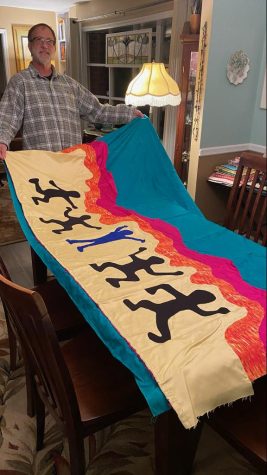
Today, Adams is still in the process of creating Brandon’s patch on the National Memorial Quilt. He has struggled to finish and submit the patch because of his attachment to Brandon. In a letter written to Brandon 30 years after his passing, Adams wrote that he wants to get the patch “just right,” and that he is “not quite ready” to finish their chapter together.
Although it’s difficult to look back on those years, Adams feels that his survival has enabled him to be a voice for those who were lost.
“It’s empowering to know that we’re making a difference by bringing these panels and talking about HIV,” said Adams. “It’s empowering to know that I can do that. I am doing that. I think my friends upstairs would be super proud.”
As Wilmington says farewell to the quilt until next year, the fight against HIV continues every day. The most recent data taken in 2020 found that more than 30,000 people contracted HIV in the U.S. that year. The quilt remembers a generation lost to history, but it also reminds us that more than a million Americans still live with HIV today. Without the advocacy and education of local organizations like SEEDS of Healing and the LGBTQ Center of the Cape Fear Coast, the ultimate goal of eradication remains unobtainable.
To view the National AIDS Memorial Quilt in its entirety, you can visit the online interactive map. To learn more about SEEDS of Healing, or to make a donation, click here. To learn more about the LGBTQ Center of the Cape Fear Coast, or to donate, click here.







